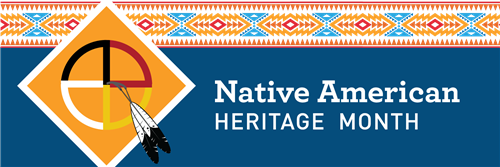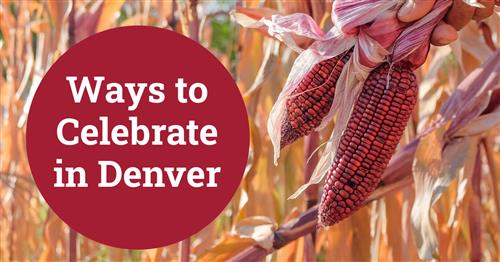Native American Heritage Month
-
Indigenous peoples are the first Americans of this country. In Colorado, we occupy the traditional and ancestral homelands of the Arapaho, Cheyenne, and Ute Nations. The month of November is established as Native American Heritage Month, and was formalized in 1990 during the Bush administration, and continues to be established through presidential proclamations since. November is a time to recognize, honor, and celebrate the diverse traditions, cultures, and languages of the first Americans. In addition, to honor our Native American veterans and service members who have courageously served and continue to serve in the armed forces. This is a time for individuals to learn and acknowledge the significant sacrifices and contributions Native Americans faced and overcame, both historically and presently. Today there are over 574 Native American sovereign Tribal nations here in the United States, each with many enrolled citizens.
In DPS, we are honoring this cultural moment with celebration of our Native community and through learning.
-
Here are some key facts to share about Native American Heritage Month:
Rich Cultural Diversity
Native Americans are not a single monolithic group but consist of over 570 federally recognized tribes, each with its own languages, customs, and traditions.
Ancient History
Native American cultures have a history on the continent dating back thousands of years. Some tribes, like the Hopi and Navajo, have lived in the same region for over a thousand years.
Stewards of the Land
Native American communities have often been deeply connected to the environment, emphasizing sustainable practices and environmental stewardship.
Contributions to Agriculture
Native Americans were early agricultural pioneers, developing crops such as maize, beans, and squash, which are staples in many diets today.
Iroquois Confederacy
The Iroquois Confederacy, a group of Native American tribes in the Northeast, influenced the development of the U.S. Constitution with their system of governance.
Code Talkers
During World War I and World War II, Native American code talkers used their languages as unbreakable codes to help secure communications for the U.S. military.
Art and Craftsmanship
Native Americans have a rich tradition of art and craftsmanship, including pottery, basket weaving, beadwork, and intricate designs in clothing and jewelry.
Literary Contributions
Native American literature, including works by authors like Sherman Alexie and Louise Erdrich, has made significant contributions to American literature.
Leadership
Prominent Native American leaders like Wilma Mankiller, Sitting Bull, and Chief Joseph have made lasting impacts through their advocacy for Native rights.
Challenges and Resilience
Native American communities have faced historical injustices, including forced removal from ancestral lands and the legacy of the Indian Boarding School era. Despite these challenges, they have shown remarkable resilience and continue to advocate for their rights and cultural preservation.
Cultural Revival
Efforts to revitalize Native American languages and cultural practices are ongoing, contributing to the preservation of these vital aspects of Native American heritage.
Sovereign Nations
Many Native American tribes maintain a unique legal status as sovereign nations within the United States, with their own self-governance and legal systems.
Land Acknowledgments
It's important to acknowledge the ancestral lands on which schools and communities are located and to pay respect to the traditional stewards of those lands.
Recognition and Respect
Celebrating Native American Heritage Month is a way to recognize and respect the important role that Native Americans have played and continue to play in American society.
Education and Awareness
Native American Heritage Month serves as an opportunity to educate and raise awareness about Native American history, cultures, and contributions, promoting cultural sensitivity and understanding.
Resources from the Academics Division
-
Resources for the Classroom
National Native American Heritage Month - What started at the turn of the century as an effort to gain a day of recognition for the significant contributions the first Americans made to the establishment and growth of the U.S., has resulted in a whole month being designated for that purpose.
Native American Culture and Education: Elementary Book Recommendations - This book list was created by Dr. Loring Abeyta. The Author and Title column indicates the number of copies available through Native American Culture and Education. For retrieving copies, contact Susie Mitchell: SUSIE_MITCHELL@dpsk12.net
Native American Culture and Education: Middle and High School Book Recommendations - This book list was created by Dr. Loring Abeyta. “*” indicates this book is available from the Native American Culture and Education book collection at DPS. For retrieving copies, contact Susie Mitchell: SUSIE_MITCHELL@dpsk12.net
NATIONAL NATIVE AMERICAN HERITAGE MONTH -November 2022 - Every year on November 1, Native American Heritage Month is celebrated to honor the remarkable Native Americans who have contributed a lot to improve the character of the nation. This month is also referred to as the American Indian and Alaska Native Heritage Month. November is the time to rejoice in diverse and rich cultures, histories, and traditions and to appreciate the great contributions of the Native Americans. This month allows us to spread awareness about tribes or to educate people about the various challenges faced by the Native Americans in the past and today.
Native Knowledge 360° - Interactive Teaching Resources - Explore parts of Native New York with your students! Native New York journeys through the city and state to investigate the question "What makes New York a Native place?" These student-friendly companion resources support and extend key messages from the exhibition, currently on view at the National Museum of the American Indian in New York City.
Vision Maker Media Native Film Collection - A collection of films about Native Americans that teachers, families, and students can view to learn more.
Native American Culture & Education | Equity & Engagement - Native American students in Denver Public Schools deserve culturally responsive approaches and practices to support academic success and overall well-being. Native American Culture and Education (NACE) supports around 1,000 Native American/Alaska Native students in Denver Public Schools, many of whom experience two worlds in their day-to-day lives as they navigate the Denver community but still have a strong cultural identity with their tribal Nations.
Digital Resources for Parents and Teachers — National Indian Education Association - The National Indian Education Association advances comprehensive, culture-based educational opportunities for American Indians, Alaska Natives, and Native Hawaiians. This resource list is developed by Native educators.
American Indian College Fund Resource Guide - We have one unwavering purpose – increasing the number of American Indians who hold college degrees. Currently, only 15% of American Indians have a college degree – less than half the national average. Every year, we empower more than 4,000 American Indian students to start and stay in school, complete their degrees and launch careers that benefit us all. We have provided 146,962 scholarships and $259.7 million to support American Indian communities. We intend to double our impact in the next five years. Join us and help a student today.
Videos for Further Learning - Tesoro Cultural Center - The Tesoro Cultural Center is proud to have produced three short educational films about the Kiowa People, the Ute Indians, and the Early Spanish Settlers of Colorado and Northern New Mexico. The films explore history, art, and culture, and use the power of oral history in doing so.
-
More Ways to Celebrate in Denver
Call for Submissions: Share Student Work & Art
-
From Nov. 1 through Nov. 30, we will be joining in local and national celebrations/recognitions of Native American Heritage Month. Is your school or community planning an event or project to honor and celebrate Native American Heritage Month? We want to spotlight your work! Reach out to dpsequity@dpsk12.org to share your school’s plans and information.














